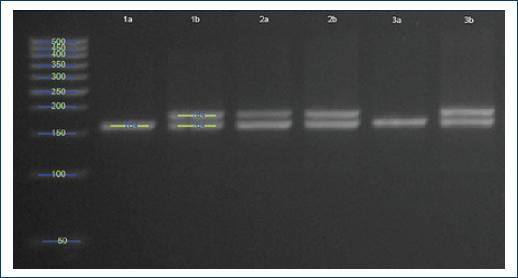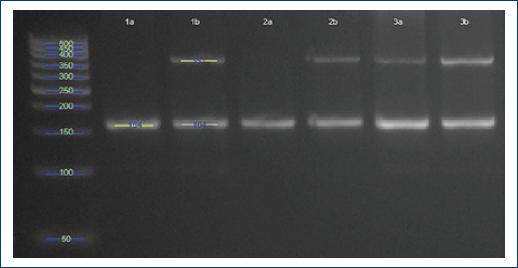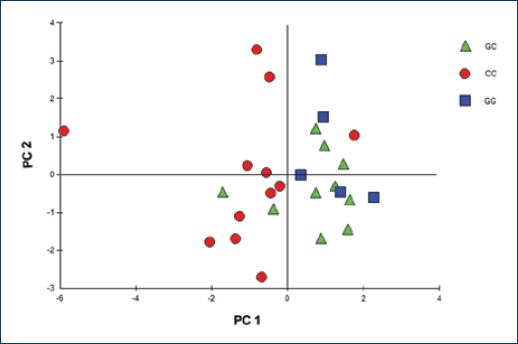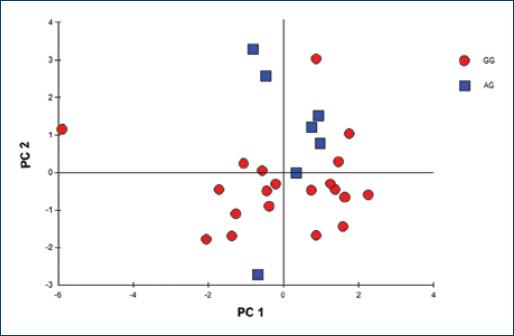Introduction
In recent years, the diagnosis and treatment of couples with fertility problems have changed significantly1. One of the factors that justify this fact is the substantial improvement in the outcome of assisted reproduction techniques2, with embryonic implantation being one of its determinants. The study of the variables involved in this process in patients treated with in vitro fertilization (IVF) has maximized efforts to transfer a single embryo in favorable cases.
A practical approach to evaluate the variability of the implantation potential among women is the use of single nucleotide polymorphisms (SNPs), namely, of genes involved in the embryonic implantation process3. Among these, those reported in tumor necrosis factor-alpha (TNFa)4 and vascular endothelial growth factor (VEGF)5,6 genes are worth highlighting, whose products act in the endometrial preparation that ensures implantation of the embryo.
It is reported that individual predisposition in combination with VEGF (+405G > C) (rs2010963) and TNFa (−308A > G) (rs1800629) polymorphisms has an impact on fertilization, embryonic implantation, and pregnancy failure rate. VEGF + 405.GG and TNFa − 308.AG or −308.AA genotypic combinations occur more frequently in women with high implantation potential, whereas VEGF + 405.CC and TNFa − 308.GG genotypic combination has been associated with a low implantation rate3.
In Cuba, in a study carried out by the Endocrinology and Human Reproduction Service of the Hermanos Ameijeiras Hospital between 2006 and 20127, 792 patients had an indication for IVF, out of the total number of patients treated in consultation. Regarding the 654 patients included in the study, 25.1% became pregnant. Although the research shows reproductive results similar to other Latin American centers that perform IVF8, the authors recommend the importance to continue refining the procedures to increase the probability of a successful pregnancy through this technique.
Among the variables that affect these results, there are the associations of TNFa (−308A > G) and VEGF (+405G > C) polymorphisms with the potential for embryonic implantation. The characterization of these genotypes would allow defining the embryo transfer of a single embryo in favorable cases, to reduce the risk of multiple pregnancy complications and the rate of implantation failure.
Methods
A cohort study was conducted at the National Centre for Medical Genetics (CNGM), between October 2017 and March 2018, in patients assessed during consultations for infertile couples at the Hermanos Ameijeiras Hospital. The aim was to establish the relationship between individual predisposition in combination with the genotypes of VEGF (+405G > C) and TNFa (−308A > G) polymorphisms and the embryonic implantation rate of patients who underwent IVF treatment.
Study population
The population consisted of 27 female patients who received treatment with IVF techniques. Female patients, who received IVF treatment due to tubal infertility and whose partners presented an optimal semen quality according to the WHO parameters9, were selected. This included a sperm recovery test that met a concentration of ≥10 × 106/L, morphology ≥ 15%, and motility of A ≥ 60%. Patients aged over 38 years, follicle-stimulating hormone levels > 10 IU/L in the blood plasma on the 3rd day of the menstrual cycle, history of chemotherapy, and/or unilateral oophorectomy were excluded from the study, as well as patients with endometrial pathology or with a history of personal autoimmune diseases.
Assisted reproduction procedures
Ovulation was triggered by the administration of Ovidrel 250 µg, within a maximum of 36 h before performing the puncture and follicular aspiration, which was guided by transvaginal ultrasound under intravenously-delivered general anesthetics. They recovered between 8 and 9 oocytes on average. From the embryonic cohort was obtained, the three best quality embryos were selected, in accordance with the criteria of Veeck (1986)10. Embryo transfer to the uterus was performed on an outpatient basis, without the use of analgesia, at which time blood samples were taken from the selected patients.
Molecular characterization
Manual DNA extraction was performed, pursuant to the standard operating procedure for DNA extraction of the Department of Molecular Biology of the responsible institution11. The extracted DNA was quantified and frozen at −20°C for preservation. To characterize polymorphisms on a molecular basis, an amplification-refractory mutation system` was standardized. The design of TNFa (−308A > G) primers was taken as reported by Vialard et al. (2013)12: F1: 5'-ATAGGTTTTGAGGGGCATGA-3'; F2: 5'-ATAGGTTTTGAGGGGCATGG-3'; R: 5'-TCTCGGTTTCTTCTCCATCG-3 '. VEGF (+405G > C) primers were designed as reported by Boudjenah et al. (2012)13: F1: 5'-CTCACTTTGCCCCTGTCG-3'; F2: 5'-CTCACTTTGCCCCTGTCC-3'; R: 5'-GAGGCGCAGCGGTTAG-3'. Two products of 184 and 351 base pairs for the TNFa and VEGF genes were amplified in a 25-cycle polymerase chain reaction, respectively, which were identified in 3% agarose gel electrophoresis (Figs. 1 and 2). As an internal amplification control, a region of the FGFR3 gene was used, whose sequences of the primer set were 5'-AGGAGCTGGTGGAGGCTGA-3' and 5'-GGAGATCTTGTGCACGGTGG-3', with a product of 164 base pairs.

Figure 1 Photograph of DNA in agarose gel electrophoresis. Tumour necrosis factor-alpha (−308A > G) polymorphism. A 50 bp molecular weight pattern is evidenced in lane 1. A case is analyzed in every two consecutive lanes. Lanes 1 and 2 of each sample identify the mutated allele and the wild allele, respectively. The 164 bp band represents the internal amplification control, and the 184 bp band represents the gene of interest. Case 1 and 3: homozygous individuals for the G allele; Case 2: heterozygous individual.

Figure 2 Photograph of DNA in agarose gel electrophoresis. Vascular endothelial growth factor (+405G >C) polymorphism. A 50 bp molecular weight pattern is evidenced in lane 1. A case is analyzed in every two consecutive lanes. Lanes 1 and 2 of each sample identify the mutated allele and the wild allele, respectively. The 164 bp band represents the internal amplification control, and the 351 bp band represents the gene of interest. Case 1 and 2: homozygous individuals for the C allele; Case 3: heterozygous individual.
Statistical analysis
UNIVARIATE ANALYSIS
The mean, standard deviation, and the range of variables of interest were computed. To evaluate the differences of the means of the computed variables, the MannWhitney U-test was applied with a significance value lower than or equal to 0.05.
POPULATION GENETICS ANALYSIS
GENEPOP 4.4 for Windows/Linux/MacOsX (2015) was used. The gene and genotypic frequencies of both polymorphisms were determined, and Hardy-Weinberg (HW) equilibrium was calculated by applying the Chi-square goodness of fit test, considering the frequency of polymorphisms in the Cuban population referred to in the CNGM databases of Cuba.
PRINCIPAL COMPONENT ANALYSIS (PCA)
A PCA was performed using the Primer 5 for Windows program, Version 5.2.9 (2002). The linear combination coefficient was calculated to determine the contribution of the variables to the PCA model. The generated graphics enabled the analysis of the presence of subgroups in the population under study, according to the genotypes of SNP markers.
Results
Study cohort characteristics
Twenty-seven Cuban patients, who received IVF treatment at the Hermanos Ameijeiras Hospital, were included in this study. Table 1 shows the clinical-therapeutic characteristic features of the study cohort according to the pregnancy diagnosis. Statistically, significant differences are evident between the mean basal E2 levels on the 3rd day of the menstrual cycle of the distributions of patients with a positive and negative diagnosis of pregnancy. These results are corroborated while analyzing figure 3, where it is observed that the distribution of patients with a negative diagnosis of pregnancy is symmetric, regarding the median, unlike the distribution of patients with a positive diagnosis of pregnancy, which highlights these differences.
Table 1 Clinical-therapeutic characteristics of the study cohort according to the diagnosis of pregnancy (n = 27)
| Characteristics | Negative diagnosis of pregnancy (n = 17) (Mean/Standard deviation) | Positive diagnosis of pregnancy (n = 10) (Mean/Standard deviation) | p-value |
|---|---|---|---|
| Age | 32.12 ± 4,09 | 33.00 ± 2.67 | NS |
| Obstetric history | |||
| Pregnancy history | 1.59 ± 1.54 | 1.30 ± 1.34 | NS |
| History of ectopic pregnancies | 0.88 ± 0.78 | 0.30 ± 0.48 | NS |
| History of childbirths | 0.06 ± 0.24 | 0 | NS |
| History of induced abortions | 0.41 ± 0.71 | 0.90 ± 0.99 | NS |
| History of miscarriages | 0.24 ± 0.75 | 0.10 ± 0.32 | NS |
| Basal Hormonal Levels | |||
| FSH (mUI/ml) | 6.10 ± 1.43 | 6.53 ± 1.41 | NS |
| LH (mUI/ml) | 5.24 ± 2.29 | 5.22 ± 1.31 | NS |
| E2 (pmol/l) | 61.59 ± 15.40 | 152.32 ± 120.25 | 0.006 |
| Prolactin (µUI/ml) | 305.11 ± 167.22 | 319.20 ± 114.17 | NS |
| Ovarian stimulation | |||
| FSHr dose | 203.65 ± 74.19 | 180.00 ± 38.73 | NS |
| E2 before oocyte capture | 2264.88 ± 778.46 | 2310.50 ± 996.87 | NS |
| TRA Results | |||
| Cumulative Embryo Score (CES) | 27.77 ± 13.56 | 35.90 ± 17.65 | NS |
| Embryos transferred (per patient) | 2.53 ± 0.80 | 2.70 ± 0.67 | NS |
NS: not significant; FSH: follicle-stimulating hormone.
Population structure
Twenty-seven subjects were included in the population structure analysis. It was shown that the study cohort was in HW equilibrium. The observed genotypic frequencies of the VEGF (+405G > C) polymorphism were 0.19, 0.37, and 0.44 for the GG, GC, and CC variants, respectively, while the respective genotypic frequencies of the TNFa (−308A > G) polymorphism were 0.00, 0.26, and 0.74 for the AA, AG, and GG variants. The estimated gene frequencies for the VEGF (+405G > C) polymorphism were 0.37 for the G allele and 0.63 for the C allele. As for the TNFa (−308A > G) polymorphism, the A and G alleles showed a frequency of 0.13 and 0.87, respectively.
Correlation analysis
The most "robust" variable in principal component 1 was the history of pregnancy, whereas, in principal component 2, it was the embryonic implantation rate. These results establish that the data distribution is determined primarily by these variables in the respective axes.
Figure 4 shows that VEGF.CC variant exhibits homogeneity in the lower left quadrant. This result shows that patients with this genotypic variant had a low implantation rate when they underwent IVF, while they had a positive history of pregnancy, which could result in childbirth, miscarriage, or ectopic pregnancy.

Figure 4 Representation of the vascular endothelial growth factor (+405G > C) genetic polymorphism according to principal components 1 and 2.
The present study showed significant differences between the means of the history of pregnancies when comparing the groups of patients with genotypic variants of the VEGF (VEGF.GG + VEGF.GC and VEGF.CC) polymorphism with p = 0.004. The remainder of the analysis showed no differences between the genotypic variants of this polymorphism.
Figure 5 shows that TNFa.GG variant exhibits homogeneity in the lower quadrants. This result shows that patients with this genotypic variant had a low implantation rate when they underwent IVF. At the same time, patients with TNFa.AG variant are grouped in the upper right quadrant, where a high implantation rate is evidenced in women with a positive history of pregnancy.

Figure 5 Representation of the tumor necrosis factor alpha (−308A > G) genetic polymorphism according to principal components 1 and 2.
While analyzing the group of subjects in the study cohort, according to the combination of the genotypes of the VEGF (+405G > C) and TNFa (−308A > G) polymorphisms, it is observed that the VEGF.CC/TNFa.GG variant shows homogeneity in the lower quadrants (Fig. 6). This result shows that the patients with these genotypic variants had a low implantation rate when they underwent IVF.
Discussion of the results
Among the clinical therapeutic characteristics of the study cohort, an average age of 32 years stands out, which is considered suitable for the procedure, according to data from a previous study conducted by Rodríguez et al. (2015)7 at the same institution. The selection of patients with the estimated average age reduced the probability of assigning negative results, regarding the applied technique, to confusing variables.
Statistically significant differences were evident in both groups (positive diagnosis of pregnancy vs. negative diagnosis of pregnancy) with respect to basal E2 levels on the 3rd day of the menstrual cycle. Analysis of estradiol (E2) between day 2 and 4 of the menstrual cycle allows for an evaluation of the ovarian reserve. The clinical interpretation of blood levels depends on the reference values of the laboratory involved (E2: 90.1-716 pmol/L in the present study). An E2 level of < 500 pmol/L is generally deemed normal14. When E2 levels are > 500 pmol/L, the negative feedback effect acting on the hypothalamus and pituitary gland causes a decrease in follicle-stimulating hormone (FSH), which can cause an erroneous interpretation of its levels.
Mean E2 levels in the group of patients with a negative diagnosis of pregnancy (Table 1) were below the lower limits (90 pmol/L) between days 2 and 4 of the menstrual cycle. The literature does not refer to the consequences of these minimum values during an assisted reproduction process. However, estradiol plays a relevant role as a growth hormone for the reproductive organs, supporting the lining of the vagina, cervical glands, endometrium, the lining of the fallopian tubes, and the maintenance of the ovarian reserve15.
Regarding the population structure of the study cohort, there were no statistically significant differences regarding the gene and genotypic frequencies reported in international studies16. However, the fact that the frequency of homozygous TNFa.AA was equal to zero is noticeable. An important implication of the Hardy-Weinberg Law, which was evident in the present study, is that, for a rare allele, the frequency of heterozygotes is much higher than that of the unusual homozygote. This argument proves the difficulty in eliminating the recessive deleterious alleles of the populations, as most of them are in a heterozygous state, and natural selection cannot act against them.
The homogeneity group shown by the PCA in figure 4 coincides with the results of the previous study conducted by Boudjenah et al. (2014)3, where it was evidenced that patients with the VEGF.CC variant have a lower embryonic implantation rate.
VEGF is an essential protein in the angiogenesis process17. It has been reported that the VEGF.CC genotypic variant of its +405G > C polymorphism is related to a reduction in gene expression18. The decrease in VEGF expression causes a decrease in its secretion by follicular theca cells (granulosal-lutein and theca-lutein cells) before ovulation, reducing the formation of new blood vessels at the ovarian level. VEGF synthesis by granulosal-lutein cells is decisive for the development of a healthy preovulatory follicle, while its secretion by theca-lutein cells guarantees follicular growth. This argument allows us to state that a low vascularization limits the hormonal and nutrient supply, leading to the formation of low-quality ovules19.
The endometrial expression of VEGF increases during the late secretory endometrial phase and reaches its peak during ovulation. A decrease in its expression leads to the abnormal invasion of cytotrophoblast3, which is decisive in embryonic invasion and directly affects the implantation rate.
The homogeneity group shown by the PCA in figure 5 coincides with the results of the previous studies conducted by Boudjenah et al. (2014)3 and Vialard et al. (2013)12, where it was evidenced that patients with the TNFa.GG variant had a lower embryonic implantation rate, while patients with the TNFa.AG variant had a higher embryonic implantation rate.
TNFa is involved in a broad spectrum of biological processes that include cell proliferation, cell differentiation, apoptosis, coagulation, and lipid metabolism20. In the field of reproduction, it has been identified in glands, endometrial stroma, and the maternal-embryonic interface. The inflammation generated by the TNFa expression is deemed favorable during preimplantation and implantation periods, which is why it has been considered as one of the essential genes in the process that regulates endometrial receptivity21.
The production of this cytokine in endometrial cells maximizes its levels during the secretory phase. Moreover, TNFa mediates its inflammatory activities through the induction of luteal prostaglandins, which promotes the development of the corpus luteum and stimulates the production of progesterone to maintain pregnancy22.
Subjects carrying the A allele at position −308 of the TNFa gene have higher transcriptional activity compared to those subjects who "carry" the common G allele. The mechanism is given because the TNFa −308A allele within the sequence −323-−285 may result in the expression of a different nuclear binding protein, which favors transcription4. These data support the results from previous studies23 and the PCA homogeneity in this report.
The homogeneity group shown by the PCA in figure 6 coincides with the results of the previous study conducted by Boudjenah et al. (2014)3, where it was evident that patients with the combined VEGF.CC/TNFa.GG variant had a lower embryonic implantation rate. However, the cited work refers that the VEGF.GG + GC/TNF.AA + AG variants show a positive predisposition to adequate embryonic implantation, an argument that cannot be demonstrated in the present study. The unfavorable effect of the VEGF.CC/TNFa.GG combination is related to the homozygosis status of allelic variants that lead to a decrease in the transcriptional activity of both genes, that is, that the combined action demonstrates the reducing effect of the gene expression of both factors individually.
The limitations of the present study allow us to recommend the development of cohort studies with a greater number of participants, in addition to experimental studies that allow us to increase the understanding of the action of these genes in the embryonic implantation process.











 nueva página del texto (beta)
nueva página del texto (beta)




